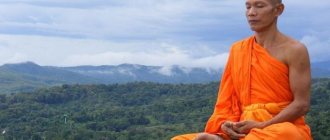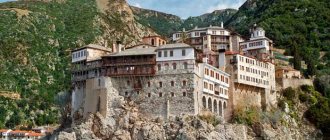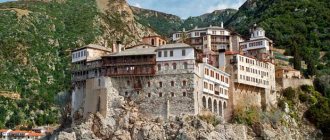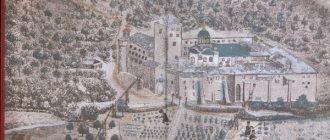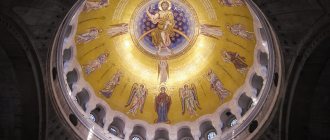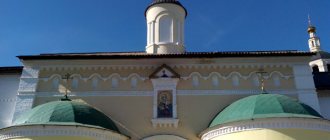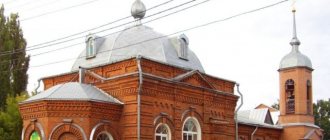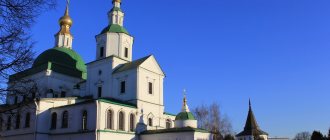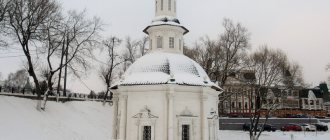Holy Mount Athos in Greece is a small peninsula, one of the branches of the resort of Halkidiki, an incredibly picturesque place with amazing nature. There are two dozen monasteries here. Mount Athos is one of the most mysterious places, surrounded by legends. According to one legend, the mountain rose from the depths of the sea at the behest of the god Poseidon. With her help, the gods suppressed the uprising of the Titans. And according to another legend, Titan Athos, during the uprising, dropped a huge stone, which became a mountain.
general information
Capital: Karye (Kareya).
Governance: The sovereignty of Athos is secured by the Treaty of Lausanne in 1923, and since 1926 the peninsula has been part of Greece. The Autonomous Monastic State of the Holy Mountain is a self-governing community consisting of 20 Orthodox monasteries and based on the provisions of the first Charter of the Holy Mountain ("Tragos").
Geography: The Holy Mountain Peninsula occupies the extreme eastern tip of the Halkidiki peninsula. The local terrain is a gradual transition in the southeast direction from the lowland to the rocky mountain range, which ends in a pyramid (height - 2033 m).
Area: 335.63 km2
Climate: Subtropical (Mediterranean). The peninsula has mild, rainy winters and fairly hot summers. Snow falls relatively rarely and melts quickly. The main source of drinking water is streams flowing from the mountains.
Population: 2262 people (2001)
Population density: 6.7 people/km2
Features: On Athos, the Julian calendar is used everywhere, including in administrative documents. The Holy Mountain is a UNESCO World Heritage Site. Women are prohibited from entering the territory of the “monastic republic”.
Athos is a peninsula crowned by the mountain peak of the same name. This is a place of constant prayer to God. On the territory of a unique monastic republic, the population of which is represented exclusively by men, there are 20 monasteries and 12 hermitages.
The Holy Mountain is the center of the Orthodox world, the focus of its priceless wealth. The monasteries contain manuscripts and icons, relics and relics of saints (including part of the relics of Ivan the Baptist and the remains of Mary Magdalene), and even part of the cross on which Jesus was crucified.
Gregoriate Monastery. Saint Athos
My country is Athos! My sweet peninsula! You are pierced into my chest with Your sharp peak!
Why did he cut me into two unequal parts? One is a bundle of love, the other is a bundle of pain! Hieromonk Simeon
What do the monasteries of the Holy Mountain keep?
Athos monasteries are amazing treasuries of Byzantine icon painting. For centuries, monks have been protecting wall paintings and rare frescoes, preserving unique icons and Holy relics, over which time has no power. They not only saved, but also increased the spiritual wealth of Orthodoxy.
Among the most significant shrines accessible to pilgrims for worship is part of the Life-Giving Cross of the Lord, carefully preserved by the monks of the Xiropotamus monastery. Belt of the Blessed Virgin Mary, which can be venerated in the Greek monastery of Vatopedi. And in the Russian St. Panteleimon Monastery the head of the holy Great Martyr Panteleimon rests. The monks of Dionysiata saved part of the relics of the prophet John the Baptist and the miraculous Akathist icon of the Mother of God from barbarians and invaders.
And the most revered icons on Athos with the image of the Mother of God - “Gerontissa (Old Lady)” and “Portaitissa (Goalkeeper)” can be venerated in the monasteries of Pantokrator and Iviron. The monastery of St. Paul houses the gifts brought by the Magi to the newborn Jesus.
Pilgrimage to Mount Athos, to monasteries and shrines, is now very common. At the same time, not only Orthodox people, but also supporters of other religious beliefs flock to the blessed lands. After all, just being on the Holy Mountain, in the earthly lot of the Mother of God, fills the hearts of everyone with the light of God.
origin of name
There are various legends and myths explaining the origin of the name "Athos" . But only two legends have become widespread. According to one of them, in very ancient times there was a war for the possession of Mount Olympus between the Olympian gods and the Titan demigods. And during this war, the mythical Thracian giant Athos threw a stone at Poseidon. The stone fell into the waters of the Aegean Sea and turned into a peninsula. And another legend says that Poseidon defeated Athos in mortal combat and buried him under a mountain in the sea. And this mountain got its name in honor of the bravely died giant.
The name “Holy Mountain” was first mentioned in the official charter of Emperor Alexei Komnenos to the Great Lavra Monastery (1144): “From now on, Athos will always be called the Holy Mountain.” And the Christian legend tells about the events of ancient times, when the Virgin Mary and the Apostle John the Theologian were traveling on a ship that was washed ashore by a storm on the peninsula. The Mother of God was so struck by the beauty of this place and the favorable climate that she asked God for the peninsula as her inheritance, as her earthly refuge. Since then, the Holy Mountain has also been considered the “garden” of the Virgin Mary, a haven for those who want to escape.
Athos attracts pilgrims from all over the world, primarily as a stronghold of Orthodoxy. The Blessed Holy Mountain is the place of the thousand-year feat of monks who have preserved and passed on the true Orthodox faith in pristine purity to this day.
Athos
Shrines of the Pantokrator Monastery
You can give a note, just like light a candle, both to the monastery itself and to certain of its shrines. For example, to one of the two great shrines of the Pantokrator monastery - the miraculous icon of the Most Holy Theotokos “Gerondissa” and the miraculous image of St. George the Victorious.
The icon “Gerondissa”, or “Elder Woman”, especially patronizes older people. They ask the icon for a prosperous old age both for themselves and for their relatives, and also pray for people who are between life and death, in a coma, recovering from heart attacks and strokes, and suffering from heart disease. You can also pray before the “Staritsa” for protection from sudden death, death without repentance.
The image of St. George the Revealed is asked for protection from ill-wishers and human malice. The saint patronizes soldiers and members of their families, people who find themselves in a war zone. In front of the image of St. George the Victorious, they pray for consolation and support during difficult life situations, for finding peace of mind. Also, St. George the Victorious is the patron saint of cattle breeding and agriculture; You can ask him for health for animals, fertility and good harvests, protection from adverse natural phenomena. Prayer in front of the image of St. George the Victorious helps you find the right path in life and strengthen your own faith.
Pantokrator is a small monastery, occupying seventh place in the monastic hierarchy of the Holy Mountain. Twice a day prayers are offered here for the forgiveness of sins and prosperity throughout the world. During the daily Divine Liturgy, notes submitted by believers about health and repose are read and candles are lit.
Russians on Mount Athos
The presence of “Russian” monks on the Holy Mountain was started by the Monk Anthony of Pechersk (983-1073) . He went to the center of the Orthodox faith and, after staying here for a long time, he himself became a mentor for the brethren. Then the abbot sent him to the Russian land to convey the Christian faith to people. And the Monk Anthony arrived in Kyiv, where he founded the Pechersk Monastery, which became the source of Russian monasticism.
The first documentary evidence of the appearance of a Russian monastery on Mount Athos reliably dates back to 1016. Exact data on the location of the monastery has not been preserved, but indirect evidence points to the monastery of “Xylurgu”. A lot of time has passed since then and a lot has changed, but starting in 1870, the St. Panteleimon Monastery was finally recognized as Russian.
Monastery of St. Panteleimon
And to this day, the Russian monastery on Mount Athos is a significant force, conducting religious and educational activities and exerting a strong influence on Russian Orthodoxy. That is why the flow of pilgrims from Russia, striving to touch with their souls the origins of the true faith, does not dry out.
One of the great Christian ascetics, who immediately upon arriving at the Holy Mountain chose the Russian monastery of St. Panteleimon and remained here forever, was the Venerable Elder Silouan. And he, then still a young novice, was given the opportunity to know the great secret of Being. He is revered in the Orthodox Church as a saint among the venerables.
Interesting facts about Mount Athos
- Athos is a place on the planet where women are forbidden to set foot, but this particular place is the earthly destiny of the Virgin Mary.
- In the pre-Christian period, the mountain was also considered a special place - the temples of Zeus and Apollo were located here.
- Mount Athos on the map of Greece is part of the country, in fact it is an autonomous republic, there is an article about this in the main document - the Constitution. Power is concentrated in the Sacred Organs - the Cinema and the Epistasia. There is also a governor, police, post office, trade, artisans, a hospital and even banking organizations.
- The first monastery was built in 963 by Athanasius of Athos. This saint introduced the basic canons of monastic life. Today this monastery is called the Great Lavra.
- The Virgin Mary is recognized as the patroness of the entire monastic republic, since in 48, after her sermons, the local pagan residents converted to Christianity.
- The Church of the Assumption of the Blessed Virgin Mary, located in Karya, is considered the oldest on the mountain, built around 335.
- In its heyday, there were approximately 180 monasteries on the Athos peninsula. Athos received the status of an autonomous republic in 972, at that time it was patronized by the Byzantine Empire.
- Among the monasteries there is a Russian monastery - St. Panteleimon, built before 1016. There are also Serbian and Bulgarian monasteries here.
- The highest part of Mount Athos is its peak (just over 2 km), there is a temple in honor of the Transfiguration of the Lord, erected on the site of a pagan temple.
- In the southwestern part of the mountain there are hard-to-reach places - karuli - where the most ascetic monks live.
Church of the Assumption of the Blessed Virgin Mary
Monasteries
There are 20 monasteries on Saint Athos in Greece, each with premises for pilgrims and vacationers. The monks talk in detail about the history of the monastery, conduct excursions, and accommodate tourists. Of course, there are no luxury apartments here and the menu is quite modest, but people come here for something completely different.
The most famous and revered shrines of the Christian world are kept in the temples:
- icons;
- robes of saints;
- holy relics and relics.
Great Lavra
It was built in 963 by Saint Athanasius of Athos with the financial support of the emperors Nikephoros Phocas and Ioannis Tzimiskes. Throughout the ten centuries of its existence, the monastery has always ranked first among other monasteries of the Holy Mountain, partly because of its wealth, partly because of the relics stored in it (manuscripts, historical documents, cizobulls, portable icons, etc.).
The monumental structure of the monastery is especially noticeable in its large buildings. The central church (Katholikon) with two large chapels of the forty martyrs and St. Nicholas occupies the center of the monastery. Inside there is also a refectory, a kitchen, a library, etc. In the four passages surrounding the monastery there are the monks' cells, a guest house, chapels and others.
The monastery is home to 50 monks, whose daily duties are divided between their monastic duties (mass, prayers, etc.) and hospitality to the many visitors from all over the world.
The monastery is open all year round from sunrise to sunset. During the winter months, getting to the monastery is extremely difficult. Visitors wishing to examine or photograph the monastery's artwork should first contact the 10th Ephorate of Byzantine Antiquities, as well as the monastery itself.
Vatopedi Monastery
The monastery was built in the second half of the 10th century by three monks Athanasius, Nicholas and Anthony from Adrinople, disciples of St. Athanasius of Lavra.
It is a large monumental monastery surrounded by a high wall, with buildings located on the Triangle.
Inside the spacious courtyard there is a central church, a cross refectory and several chapels. Inside the central church you can see the only mosaic on the Holy Mountain, and its frescoes, painted around 1312, are attributed to the artist Manuel Panselinos of Thessaloniki. In addition to frescoes and mosaics, the monastery stores a large number of unique portable icons, manuscripts and religious objects.
About 50 monks live today in the monastery, where an extensive building project is underway to restore the large buildings.
Pilgrimage
For those who suffer to set foot on the land of the Holy Mountain and touch the origins of the true faith, there are strict rules, the observance of which is strictly observed by all pilgrims. Only men of any religious belief can come to Athos, who must first obtain permission (diamonitirion) . Orthodox clergy also need additional permission issued by the Ecumenical Patriarchate. Women are not allowed into the territory of the “earthly inheritance of the Virgin Mary,” even despite calls from the European Union to establish gender equality.
But there is a monastery in Greece where nuns live in strict accordance with Athonite rules. First of all, women come here for whom the holy land of Athos is inaccessible. The women's monastery is located in the village of Suroti, and it was founded by the Athonite elder - Saint Paisius the Svyatogorets, who until his death looked after and helped the nuns with wise advice. He was buried outside its walls and many pilgrims seek to venerate the holy relics, which have miraculous powers.
While on the Holy Mountain, pilgrims must wear clothes of soft colors that cover their legs and shoulders. It is forbidden to swim, sunbathe, talk loudly and use foul language. While living in the monasteries, each pilgrim must adhere to the daily routine common to all monks of the peninsula.
Iviron
To take photographs in monasteries, you need to ask for permission; usually, the monks do not create obstacles, but photographing the inhabitants of Athos is highly not recommended. Video filming is strictly prohibited, therefore, when going on a pilgrimage to the Holy Mountain, you should not take a video camera with you.
The Holy Mountain hides within itself a special secret of life and an extraordinary power for rebirth. And many pilgrims, after visiting these places, find spiritual peace and inner fullness.
How to light a candle at Athos shrines
Candles have been lit during services since the first centuries of Christianity. They did this not only to disperse the darkness - during pagan times, Christians were forced to hold services in dungeons and catacombs. The main reason was the desire to give the gift of light to the true Light, because “God is Light,” as it is said in the Holy Scriptures. A church candle is a gift of light that believers offer to God for Light.
On the Holy Mountain, each monastery has an apiary - each Athos candle is made from the purest natural wax. Simeon of Thessalonica wrote that candles are lit in front of the icons of saints “for the sake of their good deeds in the world.” The melting candle symbolizes the melting of the sins for which it was lit in the temple.
The Athos Guide Charitable Foundation offers the opportunity to light a candle in the Temple of Athos even if you do not have the opportunity to visit the Holy Mountain in person. To do this, just select the monastery and the corresponding shrine in the online form. The monk will light a candle for you and your loved ones within 24 hours from the moment the donations are received.
Interesting information
Without a doubt, Athos is a storehouse of spiritual values of Orthodoxy, but besides this, a huge number of valuable historical documents and cultural heritage objects are also concentrated here.
In particular:
- The world's largest collection of Greek manuscripts
- The world's largest collection of Greek (Byzantine and post-Byzantine) documents
- The world's largest collection of icons
- Record concentration of frescoes (100,000 sq. m.) in the world
- Record number of historical monuments in Greece
- The largest collection of metal and wood carvings in Greece
- The largest collection of prints in Greece
- Largest collection of Ottoman documents outside of Turkey
- The largest collection of Russian documents outside of Russia
- Largest collection of Romanian documents outside of Romania
- One of the most important collections of church textiles
- One of the most important collections of ancient Greek publications in Greece
- The largest collection of ceramics in Greece
- One of the largest collections of old photographic plates in Greece
Visiting Athos – Athos Pilgrimage Bureau
To visit Mount Athos, you need to contact the pilgrimage office and plan the exact dates of the visit, which will be included in a special pass-visa for Athos - Diamonitirion.
- Address: st. Egnatia 109, Thessaloniki 546 35
- Phones: Thessaloniki - (+30) 2310 252–575, Ouranoupolis - (+30) 23770 714–21
- Fax: (+30) 2310 222–424
The data that must be provided is first name, patronymic, year of birth, ID or passport number, date of issue and the authority that issued the document.
A representative of the pilgrimage office in Thessaloniki will provide all the necessary information regarding entry to Mount Athos from Ouranoupolis or Ierissos.
Diamonitirion is issued by the bureau office in Ouranoupolis, on the day of entry to Mount Athos.
- Opening hours: Monday to Friday from 05:30 to 13:00, Saturday from 06:30 to 13:00 and Sunday from 08:00 to 13:00. Pilgrims must arrive at least 1 hour before ferry departure.
